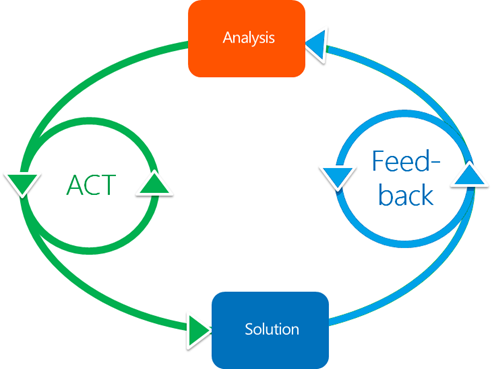Highlighting the decline of ALM Rangers Cadence
Usually “decline” is associated with a negative trend, for example decline in number of Whales or Sharks in our beautiful oceans, but in this post we are referring to a decline in cadence. Confused? Read on …
6m – 12m monster projects
In the past the ALM Rangers typically had projects spanning 6 to 12 months in duration, started twice a year after detailed analysis, priority and stack ranking by all Rangers.
As show in the illustration above, we listened to the community, the Rangers and the product group, analysed the feedback twice a year and (re-)acted.
<= 6m projects within “Gig”
With the guidance of our ingenious and patient Ruck Master Brian Blackman, teams who embraced Ruck (loose Scrum in world of Rugby) not only managed to please our Ruck Master with healthy burndown charts, but were feature complete in less than 6 months.
Key factors identified in the retrospective meetings were:
- Ruck-aware team members
- Actionable and up-to-date backlogs
- Active and transparent project leads
- Engaged team members.
- Having milestones gives teams a stake in the ground objective … razor sharp focus!
Quick Response … days, not months
But there is more. Many Rangers want shorter, more granular and independent adventures, allowing them to take ownership of a smaller feature set when and as they can. In addition with the product group adopting a shorter release cadence, we have another reason to adapt to the world of shorter release cycles and quicker release of features.
Welcome Quick Response (QR) … TFS Teams (Quick Response Sample – Command line utility to manage Team Foundation Server Teams and Users), which had the following history:
- 5th June 11:00 - Last week one of the Ranger teams raised a feature gap which blocked their project.
- We completed a feature gap analysis and defined the the exact requirements.
- 5th June 14:00 - The ALM Rangers collaborated with the product group, confirmed the gap and agreed to develop a sample for the community.
- 6th June 11:00 – The ALM Rangers developed a sample, tested the sample and successfully unblocked the VM Factory automation task.
- 9th June 12:00 – The ALM Rangers posted the DRAFT blog post and the sample, in preparation of shipping on 11th June. Had we not agreed to relax this weekend, we would have shipped on the 9th.
Thanks to Mattias, Mike, Mario, Gregg, Ben and Hakan we unblocked in less than 24 hours and published in less than a week!
So what?
So you are probably thinking … so what?
Peruse ALM Guidance: Visual Studio ALM Rangers — Reflections on Virtual Teams and How the Visual Studio ALM Rangers use Team Foundation Service to Get Ready for Visual Studio 11 and you will realise that teams are made up of part-time volunteers who are geographically dispersed around the planet. The TFS Teams out-of-band quick response solution team was represented by Rangers from Sweden, UK, Canada, East and West USA … not one co-located in the same region.
We still have a lot of work to do in terms of our ecosystem and Ruck adoption before we can embrace the Quick Response concept as a mainstream project type. What we have learned during the Visual Studio ALM Rangers “Gig”, is that the Rangers are capable of delivering top quality on time and shipping simultaneously with the product group.With the TFS Teams Quick Response Sample we have demonstrated that even the short cadence ad-hoc scenario is viable and valuable ![]()
All these leaps in adoption and innovation is not possible without the true champions in the product group, services, MVPs and communities making up the ALM Rangers family.
Rangers you “ROCK”!
 … Rock? Here is a big one in Namibia, called Hoba
… Rock? Here is a big one in Namibia, called Hoba ![]()




